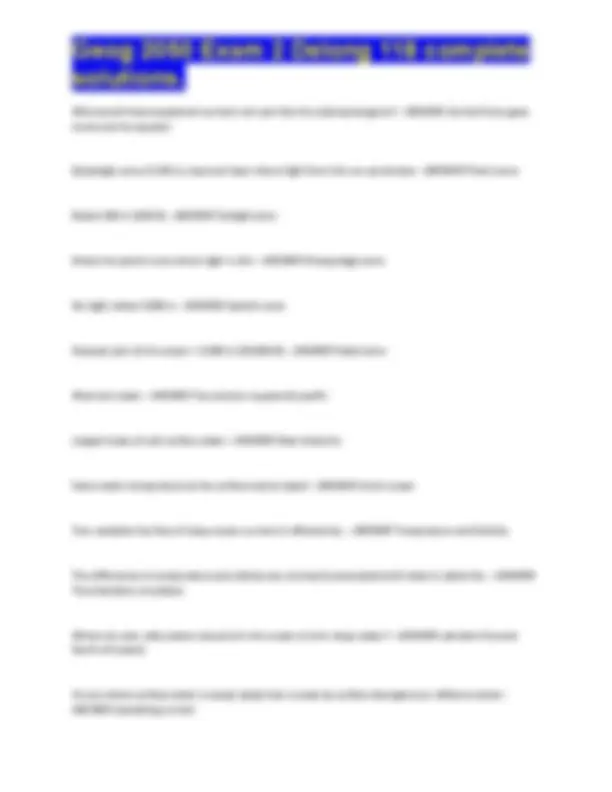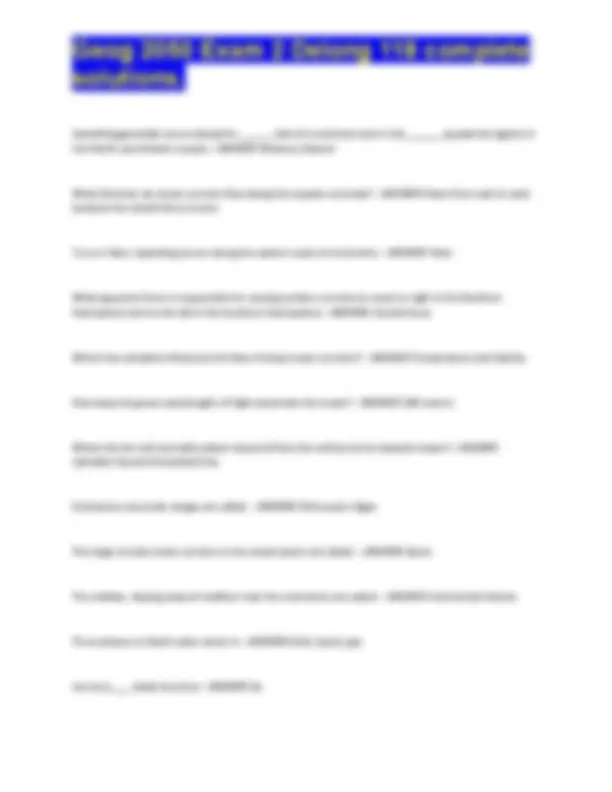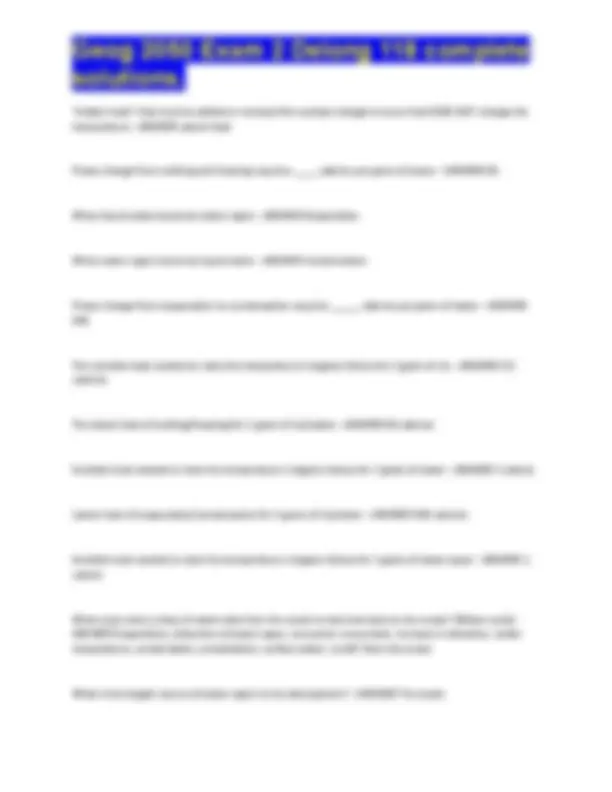








Study with the several resources on Docsity

Earn points by helping other students or get them with a premium plan


Prepare for your exams
Study with the several resources on Docsity

Earn points to download
Earn points by helping other students or get them with a premium plan
Community
Ask the community for help and clear up your study doubts
Discover the best universities in your country according to Docsity users
Free resources
Download our free guides on studying techniques, anxiety management strategies, and thesis advice from Docsity tutors
A comprehensive set of solutions to geog 2050 exam 2, covering key concepts related to oceans, atmosphere, and the water cycle. It includes answers to questions about ocean currents, ocean zones, atmospheric pressure systems, humidity, and the processes involved in the water cycle. A valuable resource for students studying introductory geography or earth science.
Typology: Exams
1 / 10

This page cannot be seen from the preview
Don't miss anything!







How much of Earth's surface do oceans cover? - ANSWER 71%
On average, how deep are Earth's oceans? - ANSWER 2.5 miles deep
What are the 5 oceans that are connected to each other? - ANSWER Pacific, Atlantic, Indian, Southern, Arctic
The largest and oldest ocean basin = 46% - ANSWER Pacific ocean
Has a submerged mountain range called the mid-atlantic ridge = 25% - ANSWER Atlantic ocean
Found mostly in the Southern Hemisphere = 20% - ANSWER Indian ocean
Surrounds Antarctica = 6% - ANSWER Southern ocean
Mostly ice-covered = 3% - ANSWER Arctic ocean
Driven by wind - ANSWER Surface ocean currents
Driven by differences in water density - ANSWER Deep ocean currents
The forces that drive surface ocean currents - ANSWER Gravity, Pressure gradient force, Coriolis force, Frictional force
Keeps the oceans in their basins on Earth's surface - ANSWER Gravity
Move water from high-pressure areas to low pressure areas - ANSWER Pressure gradient force
Acts on large distances and diverts currents to the right in the Northern Hemisphere and to the left in the Southern Hemisphere due to the spinning of Earth - ANSWER Coriolis force
At the Equator, the Coriolis force goes to: - ANSWER Zero
Coriolis force is strongest at: - ANSWER The poles
Currents are known as - ANSWER Geostrophic flow
What is the correspondence between the circulation in the ocean and the atmospheric pressure system? - ANSWER The high pressure in the atmosphere mirrors gyre circulation in the ocean
What direction is the ocean circulating in the subtropical North Hemisphere near high pressure areas? - ANSWER Clockwise
Why does the water move in it's specific direction? - ANSWER Coriolis force
Which direction does the water move in the subtropical Southern Hemisphere? - ANSWER Counter- clockwise
Places located along the Equator receive _____ hours of sunlight on a daily basis - ANSWER 12
What would you expect the temperature of the equatorial current to be? - ANSWER Warm current
Along the Equator, the surface ocean currents flow from ____to ____ - ANSWER East to west
Upwelling generally occurs along the ______ side of a continent and in the ______ equatorial regions in the Pacific and Atlantic oceans - ANSWER Western; Eastern
What direction do ocean currents flow along the equator and why? - ANSWER Flows from east to west because the coriolis force is zero
True or false: Upwelling occurs along the eastern coast of continents - ANSWER False
What apparent force is responsible for causing surface currents to move to right in the Northern Hemisphere and to the left in the Southern Hemisphere - ANSWER Coriolis force
Which two variables influences the flow of deep ocean currents? - ANSWER Temperature and Salinity
How deep do green wavelengths of light penetrate the ocean? - ANSWER 100 meters
Where do the cold and salty waters descend from the surface to the deepest ocean? - ANSWER Labrador Sea and Greenland Sea
Submarine-mountain ranges are called: - ANSWER Mid-ocean ridges
The large circular ocean currents in the ocean basins are called: - ANSWER Gyres
The shallow, sloping areas of seafloor near the continents are called: - ANSWER Continental shelves
Three phases on Earth water exists in - ANSWER Solid, liquid, gas
Ice has a ___ sided structure - ANSWER Six
"hidden heat" that must be added or removed for a phase change to occur that DOES NOT change the temperature - ANSWER Latent heat
Phase change from melting and freezing requires ____ calories per gram of water - ANSWER 80
When liquid water becomes water vapor - ANSWER Evaporation
When water vapor becomes liquid water - ANSWER Condensation
Phase change from evaporation to condensation requires _____ calories per gram of water - ANSWER 540
The sensible heat needed to raise the temperature 1 degree Celsius for 1 gram of ice - ANSWER 0. calories
The latent heat of melting/freezing for 1 gram of ice/water - ANSWER 80 calories
Sensible heat needed to raise the temperature 1 degree Celsius for 1 gram of water - ANSWER 1 calorie
Latent heat of evaporation/condensation for 1 gram of ice/water - ANSWER 540 calories
Sensible heat needed to raise the temperature 1 degree Celsius for 1 gram of water vapor - ANSWER 1 calorie
What route does a drop of water take from the ocean to land and back to the ocean? (Water cycle) - ANSWER Evaporation, advection of water vapor, encounter a mountain, increase in elevation, colder temperature, condensation, precipitation, surface water, runoff, flow into ocean
What is the largest source of water vapor to the atmosphere? - ANSWER The ocean
The energy needed to convert from one phase to another - ANSWER Latent heat
At 10 degrees C, air can hold about ____ mb of water vapor - ANSWER 11 mb
At 20 degrees C, air can hold about _____ mb of water vapor - ANSWER 22 mb
When the air parcel cannot hold any more water vapor; it is at the maximum capacity where RH = 100%
The lower the RH, the _____ the air - ANSWER Drier
The higher the RH, the _____ the air - ANSWER Wetter
Air is saturated when the RH is - ANSWER 100%
The temperature that RH is 100% - ANSWER Dew Point Temperature
The actual amount of water vapor in the air - ANSWER Absolute Humidity
The ratio of water vapor content to saturation or capacity - ANSWER Relative Humidity
The temperature of an air mass at saturation - ANSWER Dew Point Temperature
Has units of g per kilogram - ANSWER Specific Humidity
Which of the following parts of the hydrological cycle occur exclusively on land? - ANSWER Runoff, groundwater, and transpiration
Water molecules attach to each other through - ANSWER Hydrogen bonding
DAR - ANSWER Dry Adiabatic Rate
ELR - ANSWER Environmental Lapse Rate
Air that has similar characteristics that tent to stay together and we can think of them as a package in an invisible container - ANSWER Air Parcel
The Dry Adiabatic Rate - ANSWER 10 degrees C for every 1000 M
The Moist Adiabatic Rate - ANSWER 6 degrees C for every 1000 M
Normal environmental lapse rate - ANSWER 6.5 degrees C for every 1000 M
Heating water on a stove - ANSWER Diabatic process
Rising air parcel cooling - ANSWER Adiabatic expansion
Descending air parcel warming - ANSWER Adiabatic compression
What is the lifting condensation level? - ANSWER Altitude
Warm air parcels become unstable and rise - ANSWER Convection Uplift
A moving air parcel meets a mountain range, which forces it to rise - ANSWER Orographic Uplift
Windward side, no precipitation - ANSWER Fresno
Windward side, precipitation possible - ANSWER King's Canyon
Highest elevation, possibly snow covered - ANSWER Mt. Whitney
Lowest elevation and lowest humidity - ANSWER Death Valley
Good chance of clear skies at a high elevation - ANSWER Telescope Peak